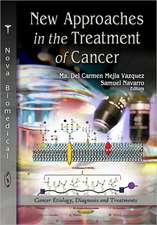Cancer as an Environmental Disease: Environmental Science and Technology Library, cartea 20
Editat de Polyxeni Nicolopoulou-Stamati, Luc Hens, Vyvyan C. Howard, N. Van Larebekeen Limba Engleză Hardback – 31 mar 2004
| Toate formatele și edițiile | Preț | Express |
|---|---|---|
| Paperback (1) | 1092.58 lei 43-57 zile | |
| SPRINGER NETHERLANDS – 31 mar 2004 | 1092.58 lei 43-57 zile | |
| Hardback (1) | 1098.12 lei 43-57 zile | |
| SPRINGER NETHERLANDS – 31 mar 2004 | 1098.12 lei 43-57 zile |
Din seria Environmental Science and Technology Library
- 15%
 Preț: 642.51 lei
Preț: 642.51 lei - 18%
 Preț: 955.70 lei
Preț: 955.70 lei - 24%
 Preț: 806.21 lei
Preț: 806.21 lei - 15%
 Preț: 637.28 lei
Preț: 637.28 lei - 18%
 Preț: 952.72 lei
Preț: 952.72 lei - 20%
 Preț: 573.76 lei
Preț: 573.76 lei - 15%
 Preț: 583.75 lei
Preț: 583.75 lei -
 Preț: 387.20 lei
Preț: 387.20 lei - 5%
 Preț: 1097.36 lei
Preț: 1097.36 lei - 18%
 Preț: 952.72 lei
Preț: 952.72 lei - 5%
 Preț: 1107.21 lei
Preț: 1107.21 lei - 18%
 Preț: 952.89 lei
Preț: 952.89 lei - 18%
 Preț: 954.62 lei
Preț: 954.62 lei - 18%
 Preț: 1229.40 lei
Preț: 1229.40 lei - 5%
 Preț: 1423.79 lei
Preț: 1423.79 lei - 5%
 Preț: 1433.83 lei
Preț: 1433.83 lei - 5%
 Preț: 1106.69 lei
Preț: 1106.69 lei - 18%
 Preț: 951.14 lei
Preț: 951.14 lei - 18%
 Preț: 729.19 lei
Preț: 729.19 lei - 18%
 Preț: 953.65 lei
Preț: 953.65 lei - 18%
 Preț: 954.14 lei
Preț: 954.14 lei - 15%
 Preț: 646.62 lei
Preț: 646.62 lei - 20%
 Preț: 590.94 lei
Preț: 590.94 lei -
 Preț: 428.56 lei
Preț: 428.56 lei - 15%
 Preț: 705.99 lei
Preț: 705.99 lei - 24%
 Preț: 840.15 lei
Preț: 840.15 lei - 24%
 Preț: 838.78 lei
Preț: 838.78 lei
Preț: 1098.12 lei
Preț vechi: 1155.91 lei
-5% Nou
Puncte Express: 1647
Preț estimativ în valută:
210.12€ • 219.98$ • 173.86£
210.12€ • 219.98$ • 173.86£
Carte tipărită la comandă
Livrare economică 07-21 aprilie
Preluare comenzi: 021 569.72.76
Specificații
ISBN-13: 9781402020193
ISBN-10: 1402020198
Pagini: 215
Ilustrații: XIX, 215 p. 9 illus.
Dimensiuni: 155 x 235 x 18 mm
Greutate: 0.51 kg
Ediția:2004
Editura: SPRINGER NETHERLANDS
Colecția Springer
Seria Environmental Science and Technology Library
Locul publicării:Dordrecht, Netherlands
ISBN-10: 1402020198
Pagini: 215
Ilustrații: XIX, 215 p. 9 illus.
Dimensiuni: 155 x 235 x 18 mm
Greutate: 0.51 kg
Ediția:2004
Editura: SPRINGER NETHERLANDS
Colecția Springer
Seria Environmental Science and Technology Library
Locul publicării:Dordrecht, Netherlands
Public țintă
ResearchCuprins
Introduction: Cancer and the Environment — Revisiting Traditional Views of Involuntary Exposure to Carcinogens.- Summary.- 1. Introduction.- 2. Cancer and the Environment.- 3. Competing Theories of Aetiological Mechanisms in Cancer.- 4. Exposure to Carcinogens in Early Life — A Strong Indication That Environmental Influences are Important.- 5. Goal of This Book.- 6. Conclusions.- References.- Incorporating the Environmental Context in the Study of Cancer — Issues and Implications.- Summary.- 1. Introduction.- 2. Evidence for the Environmental Basis of Cancer.- 3. Studying the Cancer and Environment Relationship.- 4. Implications of Risk Assessment for Cancer Policy and Intervention.- 5. Conclusions.- References.- Could the Increase in Cancer Incidence be Related to Recent Environmental Changes?.- Summary.- 1. Introduction.- 2. Cancer in Pre-Industrial Society.- 3. The Increase in Average Life Expectancy.- 4. Cancer Incidence vs. Mortality Rate.- 5. Human Epidemiological Evidence That Environmental Factors are Paramount in the Aetiology of Cancer.- 6. Could Chronic Low dose Exposure to Carcinogens Lead to Cancer?.- 7. Changes in Patterns of Human Development.- 8. Temporal Patterns of Change.- 9. Changes in the Patterns of Human Exposure to Ionising Radiation.- 10. Public Perceptions.- 11. Conclusions.- Acknowledgements.- References.- The Role of DNA Damage and DNA-Damaging Environmental Chemicals in Carcinogenesis.- Summary.- 1. Introduction.- 2. Metabolism.- 3. Chemical Carcinogenesis.- 4. Biomarkers of Exposure.- 5. Methods of Detection.- 6. Conclusions.- Acknowledgements.- References.- Gene-Environment Interaction in Environmental Carcinogens.- Summary.- 1. Introduction.- 2. Metabolism of Chemical Carcinogens.- 3. Gene-Gene Interaction.- 4. Defence againstOxidative Stress.- 5. Conclusions.- References.- Health Impact Assessment of Accidents with Environmental Carcinogens — A Case Study of the Belgian PCB/Dioxin Incident in 1999.- Summary.- 1. Introduction.- 2. Phenomenology of the Belgian PCB/Dioxin Incident in 1999.- 3. Hazard Identification.- 4. Dose-Response Assessment.- 5. Exposure Assessment.- 6. Risk Assessment.- 7. Conclusion.- References.- Anti-Oxidants and Chemopreventive Agents as Cancer Enhancing Agent: The Other Side of the Coin.- Summary.- 1. Introduction.- 2. Co-Carcinogenic Properties of ßCT.- 3. The Co-Carcinogenicity of ! -Carotene Enhances the Transformation Potential of Benzo[a]pyrene and Cigarette Smoke Condensate.- 4. Cruciferae Vegetables, Glucosinolates and Chemoprevention.- 5. Co-Carcinogenic Properties of Glucoraphanin, the Natural Bioprecursor of Sulforaphane.- 6. Conclusions.- Acknowledgements.- References.- Legislative Proposals for Reversing the Cancer Epidemic and Controlling Run-Away Industrial Technologies.- Summary.- 1. Losing the Winnable War against Cancer (Epstein, 1998).- 2. The Legislative Proposals.- 3. The Precautionary Principle: Prohibition of New Carcinogenic Products and Untested New Technologies.- 4. Reduction of Toxics in Use.- 5. Right-To-Know.- 6. Transparent Decision-Making on Cancer, Other Public Health and Environmental Effects.- 7. White Collar Crime.- 8. Independent Citizen Health and Safety Agency.- References.- Re-Evaluation of Priorities in Addressing the Cancer Issue: Conclusions, Strategies, Prospects.- Summary.- 1. Introduction.- 2. Scientific Basis for Cancer as an Environmental Disease.- 3. Target Groups.- 4. Policy.- 5. EU Policy.- 6. Conclusions.- References.- List of Abbreviations.- List of Units.














